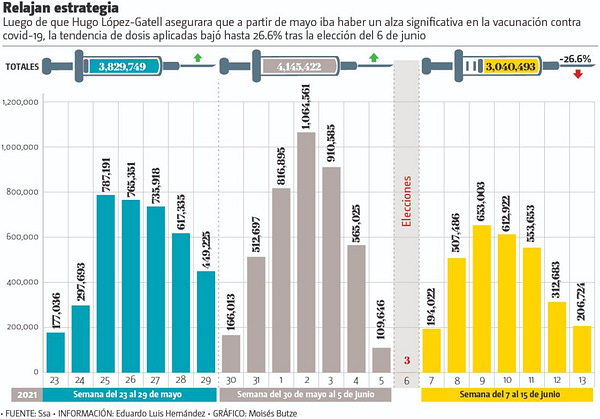Region - Covid-19 Vaccination and Hospitalization Updates
Vaccination rates are picking up across the region, but there are reasons to be concerned about new variants.
Today’s newsletter covers updates on the current situation for vaccinations and hospitalizations due to Covid-19 throughout the region.
Transmission and hospitalizations continue at alarmingly high rates.
Last week, the Americas reported 1.1 million new cases, according to the World Health Organization and almost 32,000 new deaths. Brazil had the highest number of new cases (454,710), followed by Argentina (177,693) and Colombia (176,661).
Medical systems remain overwhelmed in the region’s COVID hotspots. Eleven states and the federal district in Brazil have ICU occupancy rates above 90 percent. Fiocruz wrote in its most recent pandemic bulletin:
“In some states and the federal district it is possible that the management of availability and blockage of ICU beds is taking place with the maintenance of the indicator at a high level. However, the dominant situation is undoubtedly that of the lack of control of the pandemic.”
The ICU capacity in Colombia and Argentina is similarly strained: in Bogotá, almost 96 percent of ICU beds are filled, and in Buenos Aires, almost 94% of ICU beds are filled.
Deaths appear to be decreasing relative to new infections. This is likely due to having prioritized older populations during vaccinations, meaning younger individuals now make up a larger share of new infections and hospitalizations. Although infections remained stable week-on-week in the Americas, deaths fell 7 percent in comparison to the week before.
Vaccines are being distributed throughout the hemisphere (slowly), and the numbers are now starting to hit the levels where they should start having an impact on cases and deaths.
Chile leads the Western Hemisphere in vaccinations, with 48 percent of its population fully vaccinated and over 60 percent of its population having received at least one dose, according to data from Johns Hopkins University and the WHO. Uruguay is another strong performer, with over 36 percent of its population vaccinated and nearly 60 percent of its population having received at least one dose.
Source: Our World in Data
Countries that have struggled enormously with containing the virus for considerable periods of the pandemic have made considerable strides with vaccinating their citizens: almost 28 percent of Argentines, almost 24 percent of Brazilians, and nearly one fifth of Mexicans have received at least one dose of a vaccine. Even Peru, which has had the highest excess death tally in the world is approaching 10 percent of the population having received at least one dose.
However, vaccine supply bottlenecks continue to limit countries’ ability to ramp up distribution. Milenio reported that vaccine uptake in Mexico dropped 26 percent last week compared to the week before, citing delays in vaccine delivery from Pfizer, AstraZeneca, CanSino, and of the Russian Sputnik V vaccine as a contributing factor.
Vaccine supplies need to grow significantly to meet need and the World Health Organization recently urged wealthy countries to prioritize Latin America when making donations.
Countries’ pandemic responses are further complicated by the emergence of more virulent strains of the virus.
Variant tracing is fairly limited within Latin America, but is worth noting that the Delta variant (previously referred to as the India variant prior to the new naming convention that is trying to avoid geographic-linked names) has been recorded in several countries including Argentina, Brazil, Peru, and Mexico.
While existing vaccines should protect against new variants, they provide less protection, particularly for those who have only received one dose. Unvaccinated individuals are more susceptible to emerging COVID-19 strains and hospitalization rates appear to be higher among those who are infected with the Delta variant.
Thanks for reading
Lucy Hale helped with the research and drafting of today’s newsletter.







